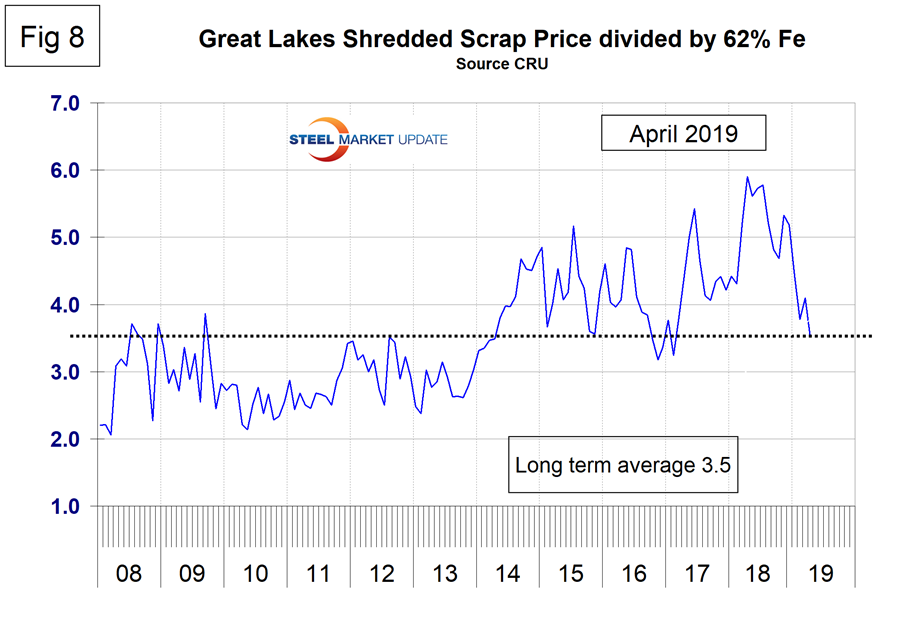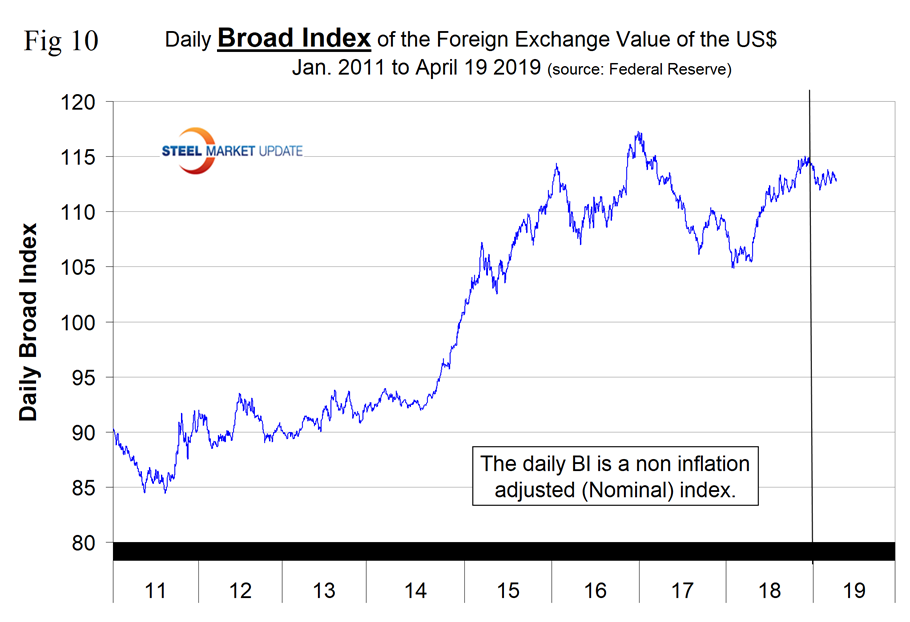Steel Products Prices North America

Raw Material Prices: Iron Ore, Coking Coal, Pig Iron, Scrap and Zinc
Written by Peter Wright
May 1, 2019
Coking coal, scrap and zinc prices have weakened in the last month.
Table 1 summarizes the price changes through April of the five materials considered in this analysis. It reports the month / month, 3 months / 3 months and 12 months / 12 months changes and tells us that at the three-month level only scrap experienced a price decline, but in one month coking coal, scrap and zinc declined and pig iron ex Brazil was unchanged.

Iron Ore
Based on CRU’s data, the weekly average spot price of 62% fines delivered North China was $92.20 per dry metric ton on April 17. The price increased by $6.70 in the last month and was up by 23.8 percent in the last three months. Figure 1 shows the price of 62% Fe delivered North China since January 2009. The price of ore has broken out of the $20 range that prior to February 2019 had existed for a year and a half.

From Mining.com April 18: ”A tropical cyclone hit Western Australia in late March, causing operation disruptions and port damages that would affect some 25 million tonnes of iron ore production, according to Fitch Ratings. The ratings agency expects some of the supply tightness and market dislocation to be transitory, the gap of lost production to narrow, and the price of iron ore to soften in the second half of 2019.”
Coking Coal
The price of premium low volatile coking coal FOB east coast of Australia declined in January and has been trading in a narrow range since then settling at $205 / metric ton on April 23. The price has ranged between $179.50 and $235 / mt since October 2017. (Figure 2).

Pig Iron
Most of the pig iron imported to the U.S. currently comes from Russia, Ukraine and Brazil with additional material from South Africa and Latvia. In this report, we summarize prices out of Brazil and average the FOB value from the north and south ports. The price was unchanged in April and has traded in a $12.50 range since September last year. The average price in April was 11.5 percent lower than in April last year.

Scrap
To put this raw materials commentary into perspective, we include here Figure 4, which shows the spread between busheling in the Great Lakes region and hot rolled coil Mid West U.S. through mid-April 2019, both in dollars per net ton. The spread has collapsed from $564 in August last year to $374 in April 2019 and is approaching a more historically normal range.

Figure 5 shows the relationship between shredded and busheling both priced in dollars per gross ton in the Great Lakes region. This spread declined to $25 in February and March and recovered to $30 in April.

Figure 6 is a scatter gram of the price of Chicago shredded and the monthly Broad Index value of the U.S. dollar as reported by the Federal Reserve. The latest data for the monthly Broad Index was March. This is a causal relationship with a negative correlation of over 74 percent, but recent data is further from the norm than at any time in the last seven years.

There is a long-term relationship between the prices of iron ore and scrap. Figure 7 shows the prices of 62% iron ore fines delivered N. China and the price of shredded scrap in the Great Lakes region through mid-April 2019. The correlation since January 2006 has been over 80 percent. There has been a very unusual divergence in these prices since Q2 2017, but that discrepancy has closed since January.

In the last 10 years, scrap in dollars per gross ton has been on average 3.4 times as expensive as ore in dollars per dry metric ton (dmt). The ratio has been erratic since mid-2014, but at 3.5 in April has come back in line (Figure 8). Since Chinese steel manufacture is 95 percent BOF, China is more competitive on the global steel market when this ratio is high. In the last four years, there have been times when China could supply semi-finished to the global market at prices competitive with scrap.

Zinc
The LME cash price for zinc mid-month is shown in Figure 9. The latest data is for April 17 when the price was $1.30 per pound and breaking out to the upside of a six-month hiatus.

Based on reports from Zinc Mining News April 16, this improvement may be short lived. “There can now be no doubting that the mined zinc concentrates segment of the market has flipped from supply deficit to surplus. The gauge of the transition comes in the form of treatment charges, which are what a zinc smelter receives from a miner for converting concentrate into metal. Spot charges have been on a steep upward trend in recent months as more raw material becomes available from new and restarted mines, such as New Century Resources, which has just reported a 50-percent jump in first-quarter production.”
Zinc is the fourth most widely used metal in the world after iron, aluminum and copper. Its primary uses are 60 percent for galvanizing steel, 15 percent for zinc-based die castings and about 14 percent in the production of brass and bronze alloys.
SMU Comment: After appreciating steadily throughout 2018 the dollar has declined in 2019, but is still relatively strong (Figure 10). There is an inverse relationship between commodity prices and the value of the U.S. dollar on the global currency markets, an example of which is shown for shredded scrap in Figure 6. However, the price of scrap has been completely out of whack for two years now as shown in Figure 11.



Peter Wright
Read more from Peter WrightLatest in Steel Products Prices North America

Nucor slows HRC price climb with $5/ton increase
After eight weeks of double-digit price increases on hot-rolled (HR) coil, Nucor slowed the price rise this week with an increase of $5 per short ton.

Domestic CRC prices surge ahead of imports
The price spread between stateside-produced CR and imports reached its widest margin in over a year.

Evraz raises plate prices $160/ton
Evraz North America (NA) has followed Nucor and SSAB with a plate price increase of its own: up $160 per short ton (st). The increase was effective immediately for all new orders of carbon, high-strength low-alloy, and normalized and quenched-and-tempered plate products, as well as for hot-rolled coil, the steelmaker said in a letter to […]

Nucor lifts HR coil to $820/ton
Nucor has increased its consumer spot price (CSP) for hot-rolled (HR) coil for a fourth consecutive week.

Nucor pushes HR spot price to $790/ton
Nucor increased its consumer spot price (CSP) for hot-rolled (HR) coil to $790 per short ton (st) on Monday, Feb. 10 – a $15/st bump vs. last week. The Charlotte, N.C.-based company has raised its weekly CSP by $40/st over the past three weeks after maintaining tags at $750/st since Nov. 12, according to SMU’s […]
